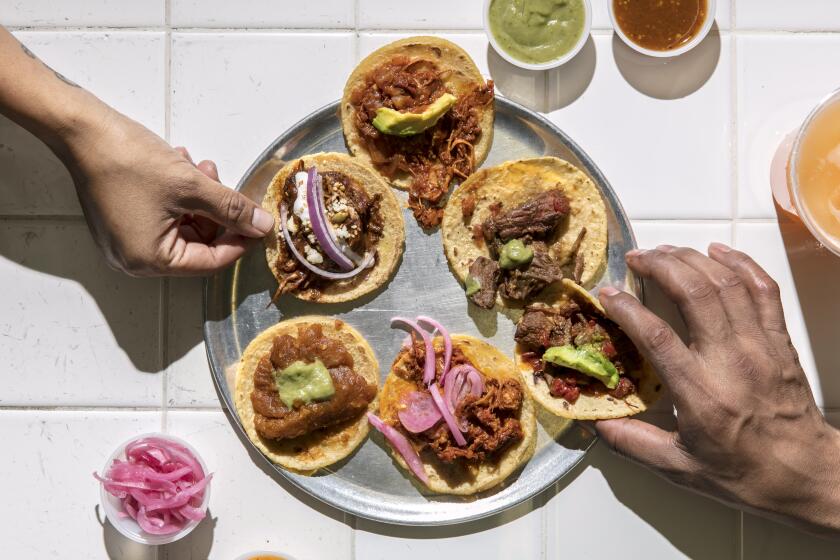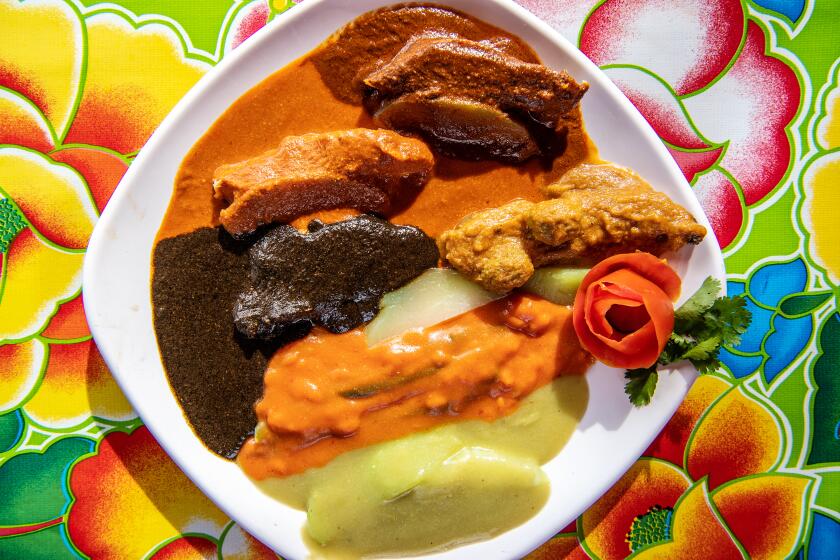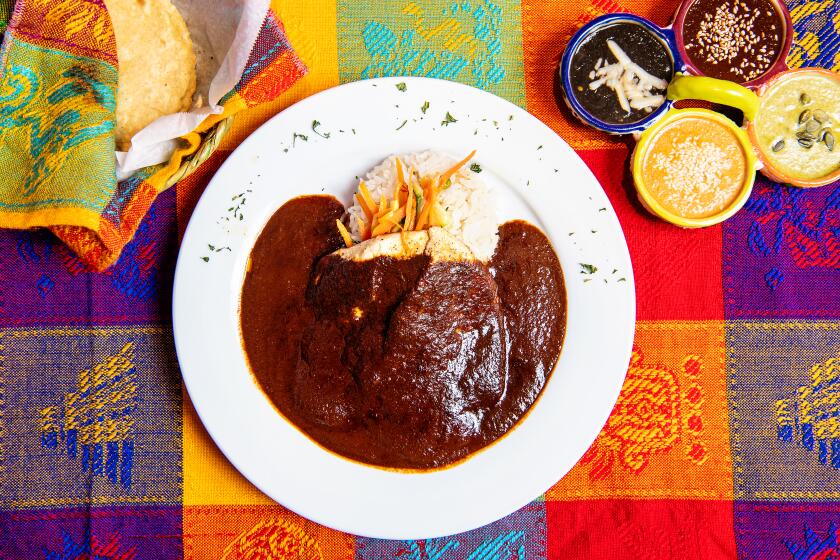Thereâs no shame in making mole from premade pastes. Here are some tips
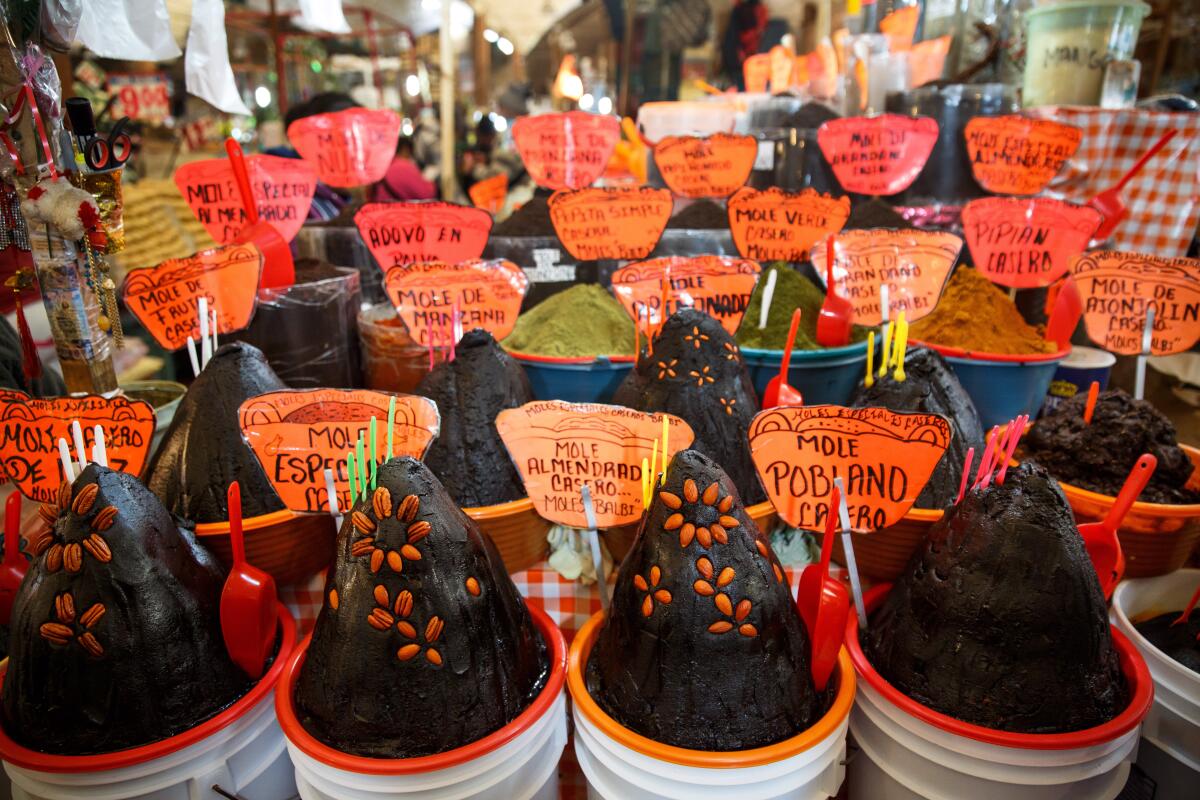
Making mole from scratch is traditionally a large-batch, multiday project â something most of us donât have time to regularly tackle. Thatâs where premade pastes come into play.
Thereâs no shame in making mole from a prepared base â many Mexican cooks buy pasta de mole at mercados big and small. All a mole base requires is rehydrating with broth, but it can be doctored with extra touches too.
The most common kind youâll find is the sienna-colored mole poblano from the city of Puebla. Mole poblano pastes are usually labeled simply as âmole.â Second to that is a mole verde with pumpkin seeds. But poke around and youâll be rewarded with other kinds of moles and their intricate tapestry of flavors.
Looking for tacos and more great Mexican food on our 101 Best Restaurants list? Itâs right here.
At mainstream supermarkets, Mexican grocers and international markets such as Super King and Jons in Los Angeles, youâll see glass containers of mole by DoĂąa Maria. Started by DoĂąa Maria Pons and her husband, Don Pedro Degetau, the company has been making mole since 1945. The story goes that the doĂąa once sold her homemade mole door-to-door; now itâs handled by Herdez and marketed in America via Hormel, the company that also sells Spam and Skippy.

DoĂąa Mariaâs regular mole (poblano) is whatâs often found on market shelves. Following the labelâs instructions to simply add broth to the paste yields a very heat-forward sauce that lacks depth. Take it to the next level by incorporating ground tomato and onion (you can grate them on the fine side of box grater if you donât have a blender), and maybe some spices. Be careful opening the container or any floating oil may go flying (pour the oil into the pan, then scrape out the paste); the glass vasito is handy for measuring broth. DoĂąa Mariaâs mole verde with pumpkin seeds offers decent complexity with a savoriness to balance with its chile heat.
Many markets also carry moles by La CosteĂąa and Rogelio Bueno, but the first is relatively meek and pudding-like, while the second is mild, with a prominent masa-like note. Beware of private-labeled moles sold at mainstream grocers; a jar of ready-to-serve organic mole negro from Whole Foods resembled a spiced tangy salsa more than a suave mole.
Los Angeles has a robust Mexican mole-making scene. Critic Patricia EscĂĄrcega considers the breadth of the cityâs mole culture.
If you shop at chain Mexican markets such as Northgate or Cardenas, youâll see the bigger brands, mentioned above, at eye level, but peruse the shelves and check near the butcher counter for harder-to-find, smaller-batch moles.
At a Northgate market in Santa Ana, there was a display of half-pint tubs of Teloloapan-style mole pastes from Guerrero, a mole hub. Reconstituted with broth, Tecampanaâs mole rojo revealed its rustic, earthy depth and edgy heat, and a mole verde from Don Cuevas proved fatty, savory and luscious.
Similarly, at a Cardenas outpost in Watsonville, Calif., I struck pay dirt: mole poblano, negro and verde by Rancho La California based in Guanajuato, Mexico. The dry, sandy pastes benefited from an initial frying in hot oil. The poblano and negro shared the same ingredient list, but the former was slightly sweet, whereas the latter was more assertive, pleasantly acrid. The verde was remarkably good and compellingly complex.
Beyond grocery stores, look to specialty food vendors such as Chiles Secos at Grand Central Market in downtown Los Angeles. Its moles are sold by weight and scooped up from glorious soft mounds, as they are in many markets in Mexico. Buy half a pound of each kind to explore their differences.
Chiles Secos carries fine pastes for Oaxacan mole rojo, coloradito and negro, but its inventory of other moles is outstanding too. The almendrado (almond) was friendly and nutty, with a moderate heat that made it a great gateway mole. The ajonjoli (sesame) was smoky, not too hot, and practically drinkable. The verde was silky and elegant like a creamy soup. The Teloloapan was smooth with well-proportioned heat, fruity sweetness and spice. The deluxe mixto was meaty upfront, with a heat that lingered afterward. Chiles Secosâ casero was velvety and sophisticated, like fine Nappa leather.
Mexican mini markets and Oaxacan specialty shops are another source. For example, I called Mi Tiendita in Fresno and found out that it sold Juquilita brand of Oaxacan mole pastes. (My brother lives in the Central Valley but couldnât get it, so I bought some online at MexGrocer.com.) Juquilitaâs rojo, coloradito and negro were all deliciously balanced. Do follow the label instructions, which I broke down to: ½ packed cup (150 g) paste with 1 cup (230 g) ground tomato (see mole paste cooking tips below) and 1 1/3 cups broth. Thatâs enough sauce for three or four servings.
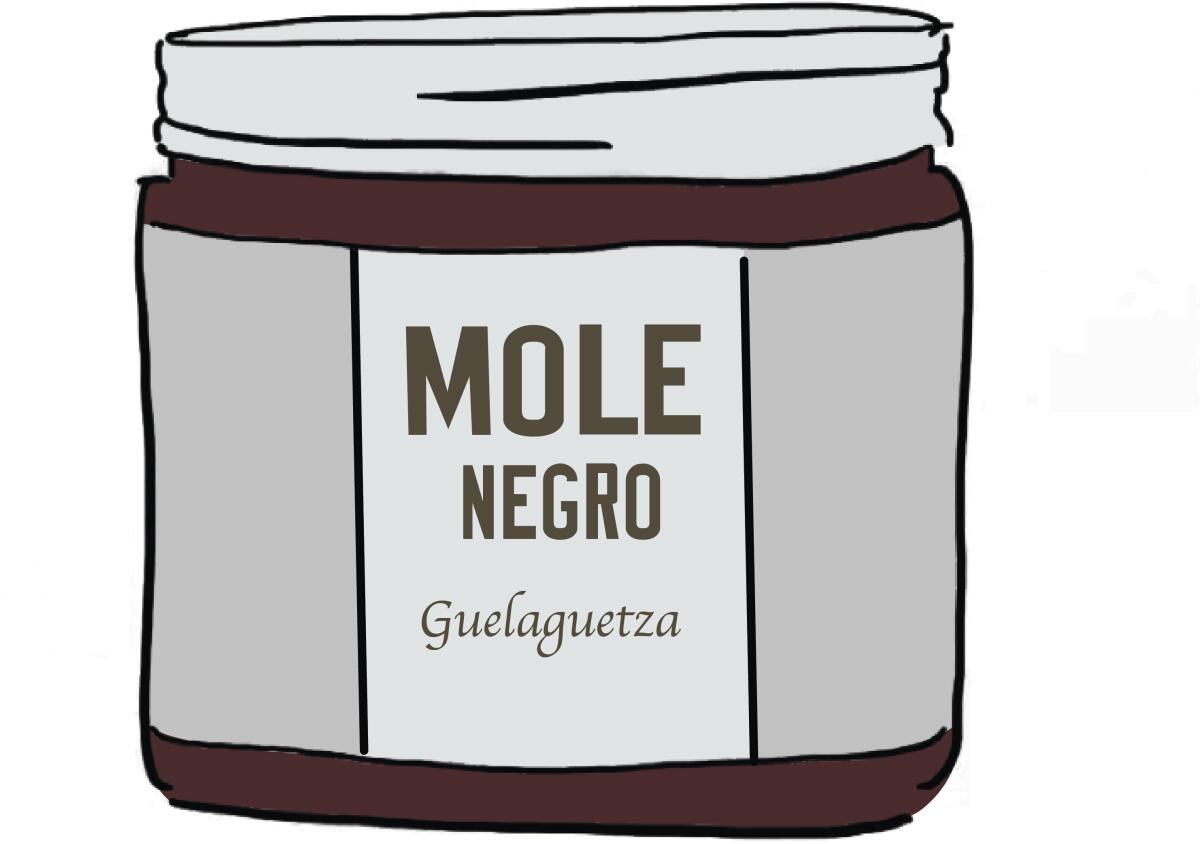
Adding tomato was part of the directions that came with the stellar Oaxacan moles sold by Guelaguetza at its restaurant and via its online shop at ilovemole.com. The rojo, coloradito and negro had distinctive flavors, vibrant color and nuanced depth. Tomato added tang, body and umami to enliven the final sauces. The full-on make-them-from-scratch mole recipes are in Bricia Lopezâs just-published cookbook âOaxaca: Home Cooking From the Heart of Mexico,â but trying the pastes first prepares you to eventually make them yourself.
Bricia Lopez of Guelaguetza talks about writing her book âOaxaca: Home Cooking From the Heart of Mexico.â
Thereâs artisanal mole on the internet too. On Etsy, I found El Molcajete, made in San Francisco by Ernesto Rodriguez and crafted from his Oaxacan motherâs recipe. As a ready-to-serve sauce, itâs a good way to get a benchmark from a small producer. It tasted of chile, dried fruit and spices, with a tomato tang to unify.
Amazon delivered me Nabora from Oaxaca, a mixture of dried ground ingredients (think devilâs food cake mix) plus a tablet of unsweetened Mexican chocolate (use the microwave to melt it). Frying the ground ingredients allows you to better witness the synergy of mole ingredients without doing much work.
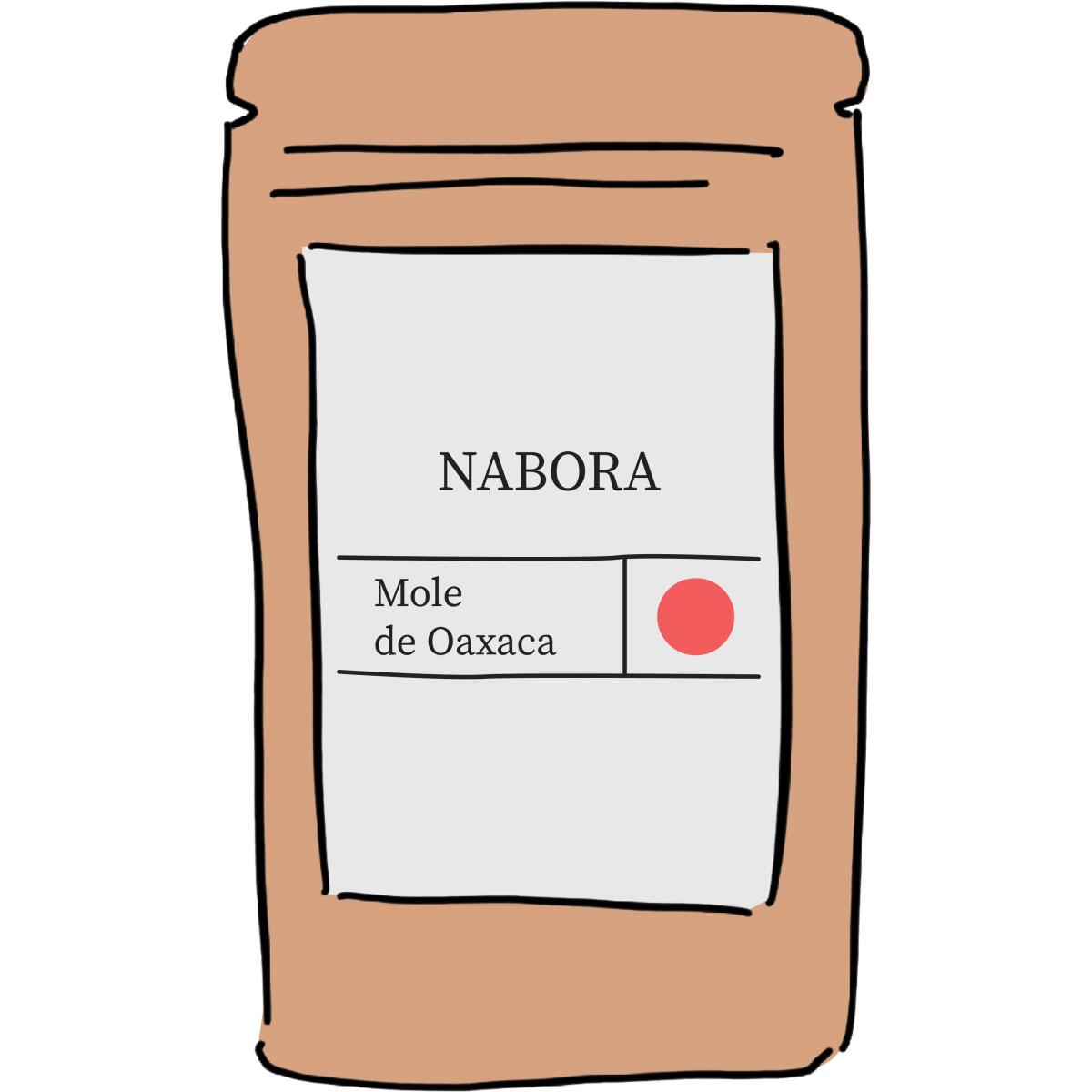
The online shop of Zingermanâs, the long-standing specialty grocery based in Ann Arbor, Mich., sells mole pastes from Susana Trilling, owner of the Seasons of My Heart cooking school in Oaxaca. Like the Guelaguetza pastes, they are a small batch product that yields true flavors. The mole rojo had piquant heat and a medium consistency.
With all these options within reach, and a minimum of work to do once youâve tracked down a paste, thereâs no reason why mole shouldnât be on your table â or your tacos or tamales â in 2020.
Mole paste cooking tips
The instructions on the mole paste labels are often brief and vague. But you have latitude in how you revive and enliven the paste to make your own mole creation.
- Use flavorful broth. Homemade is great but in a pinch, use purchased broth or bouillon; Iâve included instructions to give a Mexican flair to them.
- Some cooks heat up broth with the paste to dissolve it. But to experience the explosion of mole essences, fry the paste first: Film the bottom of a pot with a neutral oil, heat it over medium-low until hot, then dump the paste, mashing and stirring to soften, heat through and wake it up. Slide the pan to a cool burner, then add liquid ingredients. Return the pan to the burner and continue cooking.
- Add the broth gradually to avoid lumps, and allow ingredients to rehydrate well. After the sauce has a consistency you like, turn off the heat and cover the pot. Let it rest for at least 15 minutes for the flavors to bloom and meld. Mole is actually better made one or two days in advance, and the finished sauce keeps for a week or more in the refrigerator.
- The ratio of paste to liquid varies; in my experience, itâs usually 1 part paste to 3 or 4 parts liquid. Add a bit of broth or water if the sauce is too thick, or simmer it on low (expect gurgling), stirring occasionally, if the sauce is too thin.
- With dark-colored moles, such as Oaxacan rojo, coloradito and negro, I found that adding a 2:1 ratio of pureed Roma tomato and white onion (broth is still needed, though less than prescribed) consistently gave resuscitated mole pastes desirable acid, depth and body. Blend the tomato and onion, or grate them on the fine side of a box grater, then pass the results through a coarse mesh strainer, pressing on the solids.
- Donât shy away from customizing a mole to your taste. Aromatize it with spices such as ground cinnamon, clove, black pepper or anise seed, adding them by the pinch. To sweeten a mole, add a wedge of melted Mexican chocolate (or an equal amount of semisweet chocolate) or a spoon of brown sugar or grated piloncillo. Avail yourself of published mole recipes for more ideas about the range of ingredients you may tinker with.
Here are 10 L.A. Mexican restaurants serving excellent mole.
Cheaterâs Mexican-Style Chicken Broth
Yields about 4 ½ cups
When thereâs no time for from-scratch broth, give canned broth or bouillon a Mexican makeover. Vegetarian broth or bouillon can, of course, be used instead.
Ingredients
- 2 garlic cloves, smashed
- 1/4 teaspoon whole black peppercorns, cracked (use a mortar and pestle)
- 1 small (2-inch long) bay leaf, torn into a few pieces
- 1 bushy sprig fresh thyme, or 1/4 teaspoon dried thyme leaves
- 1/4 teaspoon dried marjoram leaves or 1/8 teaspoon dried Mexican oregano
Choose one:
- 1 cup water, plus 4 cups lightly salted canned chicken broth, such as Swanson
- 5 cups water, plus 2 chicken bouillon cubes (11 g)
- 5 cups water, plus 1 ½ tablespoons chicken bouillon powder or paste
Instructions
Put all the ingredients in medium saucepan. Bring to a boil over high heat, stir to dissolve the bouillon (if using), let boil hard for 3 to 4 minutes. Turn off the heat, cover and let steep for 10 minutes. Strain through a fine mesh sieve. Use or refrigerate in an airtight container for up to 3 days.
More to Read
Eat your way across L.A.
Get our weekly Tasting Notes newsletter for reviews, news and more.
You may occasionally receive promotional content from the Los Angeles Times.
